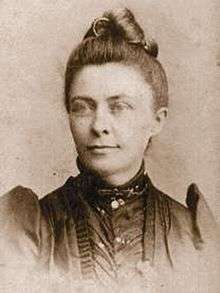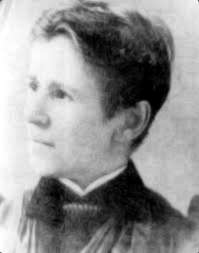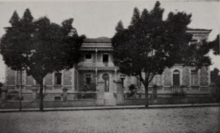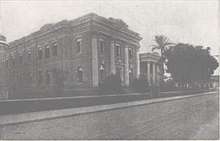Martha Watts
Martha Watts (February 13, 1848 – December 30, 1909) was an American missionary and school teacher who established four educational facilities in Brazil. Educated in Kentucky at the Louisville Normal School, she was in the first graduating class in the early 1870s and became a teacher, working in the public schools. After joining the Broadway Methodist Church in 1874, Watts joined a youth missionary society and founded a Sunday school class. In 1881, after applying to the Women's Board of Foreign Missions, she was accepted as the second woman from the United States to act as a foreign missionary and was the first woman to be sent to Brazil.
Martha Watts | |
|---|---|
 | |
| Born | Martha Hite Watts February 13, 1848 Bardstown, Kentucky |
| Died | December 30, 1909 (aged 61) Louisville, Kentucky |
| Nationality | United States |
| Other names | Martha H. Watts, Mattie H. Watts |
| Occupation | educator, missionary |
| Years active | 1881–1909 |
Arriving in the state of São Paulo in 1881, Watts' mission was to establish a school in Piracicaba. Within months, though she only had one student, Watts had opened the Colégio Piracicabano and began by recruiting a French teacher, Marie Rennotte, in 1882. At the time, most educational materials had been translated into French, as it was the universal language of education. The two women worked together to design an innovative co-educational learning environment, which offered courses in languages, literature, mathematics, philosophy, and the natural and physical sciences. Though criticized by conservative sectors of society and the Catholic Church, Watts gained powerful supporters, including prominent progressive politicians, lawyers, masons, and abolitionists. By the 1890s, the school method and curricula had gained wide support, the student body had grown substantially, and their methods were being implemented throughout the state.
Watts remained at the Colégio Piracicabano for 14 years and then established three other schools in the states of Minas Gerais and Rio de Janeiro. Failing health led to her retirement in 1909 and a return to Louisville, Kentucky, where she died at the end of that year. She is remembered in Brazil as the pioneer in bringing Methodist education to the country. An annex of the Colégio Piracicabano is named in her honor, as is the cultural center of Piracicaba, one of several facilities which bear her name or pay homage to her role in the development of a modern educational system.
Early life
Martha Hite Watts was born on February 13, 1848 in Bardstown, Kentucky, to Elizabeth Curtis/Curtiss (née Pixley/Paxley)[1][2][3] and Elijah Searcy Watts. The ninth of 12 children, she received her early education from her older siblings. Around the age of nine, she enrolled in the Bardstown Female Institute of the Methodist Episcopal Church.[1][2] Her father was a well-known attorney and soon moved the family to Louisville,[1] where Watts became engaged. Her fiancé was killed in the Civil War[4] and when the war ended she continued her studies at the Louisville Normal School.[1] The school opened in 1871[5] and Watts was in the first graduating class.[1]
Career
Early career
Watts immediately began teaching in the public school system.[1] In 1874, she joined the Methodist Church in Louisville and began regularly attending Sunday school.[6] By 1877, she had established a youth missionary society at the Broadway Methodist Church.[7] When asked by Mary Helm if she would be interested in missionary work in Brazil, Watts submitted an application to the Women's Board of Foreign Missions and was accepted in 1881,[6] becoming the first woman to be sent to Brazil by the Women's Board[8] and the second woman, after Lochie Rankin, who served in China from 1878, to be employed by the Women's Board.[9] In May 1881, Watts arrived in Rio de Janeiro in the company of James L. Kennedy, James W. Koger and his wife Frances (née Smith), and John James Ransom.[6][10] Her mission was to establish a school in Piracicaba in the state of São Paulo.[11] While Koger and his wife were to found a church there, Kennedy and Ransom were to establish a church in Rio de Janeiro.[12] By July, Watts had founded a Sunday school[10][13] and the church was organized by September 11.[12] Founding the school proved more difficult as Watts, who was not fluent in Portuguese, had to convince her neighbors to send their children to school. She also struggled to find a suitable property to rent.[14]
Colégio Piracicabano
On September 13, 1881, Watts opened the Colégio Piracicabano, having rented a space capable of serving 18 students. Only one pupil, Maria Escobar, was in attendance,[15][16] as parents were reluctant to move their children in the last quarter of the year. She was criticized for her haste in trying to open the school so quickly with three teachers for the sole student,[17] but pressure to succeed when two previous attempts to establish a Methodist mission school had failed, caused Watts to forge ahead.[18] Watts did not speak French and neither teacher Mary Newman, nor Francis Joseph Christopher Schneider, who taught Portuguese, were prepared to teach classes in the French language,[19] considered the universal language at that time. For students to study the classics in Brazil, they had to use French translations. This made securing a teacher who spoke French essential for the success of the school.[20] Watts and Rev. Ransom, wrote several letters to the Women's Board asking them to secure an American teacher who spoke French, without success.[21] On February 23, 1882, Ransom reported to the Board that he had found a "French woman" with teaching degrees who had accepted an offer of employment. Though the school term had already begun with 13 students,[22] Marie Rennotte, a Belgian teacher, did not join the staff until early March.[23]

Rennotte and Watts worked together to establish the educational vision of the school. Primarily Watts administrated the institution and Rennotte directed creation of the curricula and enhancing the reputation of the Colégio Piracicabano,[24] becoming its spokeswoman owing to Watts' limited ability with Portuguese.[25][26] Watts' approach to education was founded on Methodist ideology, which promoted a separation of church and state, individual and religious freedom, exploration of science and technology and democratic reforms aimed at producing faithful Christian servants to the nation.[27] Rennotte's method was based upon the European philosophy and pedagogical theories of scholars like Fröbel and Pestalozzi.[25][28] Together, they sought to implement innovative principles for women's education. The typical education available at the time prepared girls for domestic and social spheres and indoctrinated them into Catholicism.[29][30][31] Providing a boarding school for girls, championing co-education and gender equality, Colégio Piracicabano offered a well-rounded curriculum, including courses in languages, literature, mathematics, philosophy, and natural and physical sciences.[29] Classes were also open to boys, as lawyer Manuel de Moraes Barros sent four of his children there and encouraged others to do so.[32]
Though their curricula was approved of by progressive factions of society, the conservative elements, and specifically the Catholic Church, were harsh critics of Watts and the education provided by Colégio Piracicabano. Nonetheless, by 1883, the enrollment had reached 30 students[33] with the support of abolitionists,[Notes 1] masons, and progressive politicians like Prudente Morais Barros (brother of Manuel),[36][37] who would become governor of São Paulo and President of Brazil. He would later attempt to use the methods adopted for the Colégio Piracicabano as the model for the state's educational system and as governor, offered Watts a position as Minister of Education, to assist in founding a normal school in the state and reform education, though she declined.[38][39] With growing enrollment, Watts embarked on the construction of a new school building, which was opened in 1884.[40][41] Wanting the building ready for the start of the new school year, both she and Rennotte were closely involved in the building project to ensure both functionality and hygienic conditions as a basis for a good learning environment.[42]
Taking a leave of absence as was typical for missionaries every five years, Watts spent much of the year 1886 in the United States. In her absence, the school was run by Mary Bruce,[43] as Rennotte was also abroad gathering textbooks and class materials in Europe.[28] Seizing the opportunity, in 1887 the Literary Inspector of Education, Abílio Vianna, filed a report that the school's co-education and its failure to instruct on the Catholic religion were in violation of the Education Laws of 1851 and 1869, and demanded that boys over age 10 be removed from admittance and that a teacher be hired for Catholic instruction.[43] Reaction was swift, with prominent local newspapers and the press in Rio de Janeiro, publishing denouncements of the inspector's actions.[44] When Bruce was suppoenaed, she responded that she would not comply and would not reject students on the basis of their religion or sex.[45] In the end, the state legislature called for Vianna's resignation, allowing the school to continue with their programs.[46][47] Watts returned after her year at home and resumed her post as director.[47]
Other schools in Brazil

After 14 years at the Colégio Piracicabano, in 1895, Watts was transferred to Petrópolis with instructions to build a new boarding school there.[48] In effect, it meant starting her career over, building the Colégio Americano (American College) from scratch.[48][49][50] The girls' boarding school began with three students and rapidly the enrollment expanded to 50[51] from some of the most prominent families in the area.[49] As the school was somewhat remote and in the mountains, it gave relief from the heat and epidemics that often occurred in Rio de Janeiro at the time, allowing diplomats and officials in the nearby capital to send their daughters there for safety.[51]
Watts remained at the school until 1900 and the following year took her pentennial leave, returning to the United States.[52] Back in Brazil in 1902, she was assigned to Colégio Mineiro (Miner's College) in Juiz de Fora.[50][53] She remained at the temporary location for two years while a building was secured for a new Methodist school in Belo Horizonte.[50][53] In 1904, she inaugurated the Colégio Izabela Hendrix (Izabela Hendrix College) in the capital city of Minas Gerais with five students, but had over 60 enroll for the following year. In 1905, Blanche Howell was hired as Watts' assistant and the two worked together on the school's establishment.[54] In 1907, Watts returned to Colégio Piracicabano for the dedication of an annex to the school which was named in her honor.[41] Though the cornerstone was laid in 1907, the Martha Watts Annex was not completed until 1912.[55] Suffering from ill-health, Watts returned to the United States in early 1909.[54]
Death and legacy

Watts fell when stepping out of a carriage in Greenville, Kentucky in the spring of 1909 and never recovered from the complications of breaking her hip.[1][56] She died on December 30, 1909, at her brother W. O. Watts' home[1][57] and was buried at Cave Hill Cemetery on January 2, 1910.[57] A memorial service for her life and work was hosted by the Methodist Missionary Society on January 5, 1910, in Louisville.[58] Watts is recognized as the pioneer who brought Methodist education to Brazil and for her role in the development of a modern educational system in the country.[59][60]
In 1947, the Escola Normal Livre Miss Martha Watts (Miss Martha Watts Free Normal School) was established next door to the Colégio Piracicabano. It operated until 1970, when the government abolished normal school training.[53] The Colégio Piracicabano was eventually transformed into the Methodist University of Piracicaba in 1975, after having expanded its curricula to offer tertiary courses in 1964.[61][62] There is a bronze bust of Watts in the hall of the Colégio Izabela Hendrix, recognizing her role in founding the school.[63] The Centro Cultural 'Martha Watts' (Martha Watts Cultural Center) located on Rua Boa Morte in Piracicaba was established in 2003 and pays homage to her "ações que visavam transformar as pessoas, seus costumes, seus hábitos, suas crenças levando-as ao desenvolvimento, tanto intelectual como espiritual" (actions aimed at transforming people, their customs, their habits, their beliefs—leading them to both intellectual and spiritual development).[64][65]
Notes
- Watts was an abolitionist and soon after her arrival in Brazil, she bought the slave Flora Blumer de Toledo and manumitted her. Blumer in turn became an employee of Watts and worked at the Colégio Piracicabano until 1892, when she died.[34][35]
References
Citations
- The Courier-Journal 1909, p. 2.
- John 1899, p. 19.
- Pixley & Hanford 1900, p. 38.
- Sarat De Oliveira 2007, p. 7.
- Fridell 2001, p. 658.
- John 1899, p. 20.
- Howell 1928, pp. 54–55.
- Costa Ramires 2009, p. 31.
- Howell 1928, p. 68.
- Cachioni 1997, p. 60.
- Costa Ramires 2009, p. 41.
- Costa Ramires 2009, p. 44.
- Kennedy 1928, p. 25.
- Costa Ramires 2009, p. 45.
- Costa Ramires 2009, p. 46.
- Colégio Piracicabano 2016.
- Costa Ramires 2009, p. 48.
- Costa Ramires 2009, p. 49.
- Costa Ramires 2009, pp. 41, 53, 55, 57.
- Costa Ramires 2009, p. 51.
- Costa Ramires 2009, pp. 51, 55-56.
- Costa Ramires 2009, pp. 56-57.
- Costa Ramires 2009, p. 59.
- Costa Ramires 2009, pp. 73–75, 84.
- De Luca & Assis De Luca 2003, p. 706.
- Belgian Club of Brazil 2018.
- Sarat De Oliveira 2007, pp. 5–6.
- Mott 2005, p. 46.
- Mott 2005, pp. 45–46.
- Sarat De Oliveira 2007, pp. 6, 14–15, 19.
- Mesquita 2002, p. 100.
- Costa Ramires 2009, p. 62.
- Sarat De Oliveira 2007, p. 17.
- Fuzeti Elias 2018a.
- Moura da Silva 2012, p. 6.
- De Luca & Assis De Luca 2003, pp. 706–707.
- Sarat De Oliveira 2007, p. 16.
- Dawsey & Dawsey 1998, p. 129.
- Moura da Silva 2012, p. 7.
- Costa Ramires 2009, p. 70.
- Vicentini 2018.
- Costa Ramires 2009, pp. 70–71.
- Kennedy 1928, p. 323.
- Kennedy 1928, pp. 323–324.
- Kennedy 1928, p. 324.
- Costa Ramires 2009, pp. 80–81.
- Kennedy 1928, p. 325.
- Mesquita 2002, p. 104.
- Dawsey & Dawsey 1998, p. 130.
- Moura da Silva 2012, p. 5.
- Kennedy 1928, p. 338.
- Moura da Silva 2012, pp. 5, 14.
- Pfromm Netto 2013.
- Kennedy 1928, p. 353.
- Fuzeti Elias 2018b.
- The Record 1909, p. 3.
- The Courier-Journal 1910b, p. 16.
- The Courier-Journal 1910a, p. 8.
- Lopes 2010, pp. 11, 14.
- Dawsey & Dawsey 1998, p. 103.
- Dawsey & Dawsey 1998, p. 131.
- Universidade Metodista de Piracicaba 2018.
- van der Krogt & van der Krogt 2017.
- Fuzeti Elias 2018c.
- Gazeta de Piracicaba 2017.
Bibliography
- Cachioni, Marcelo (1997). "O metodismo em Piracicaba tem a sua história" [Methodism in Piracicaba Has Its History]. Revista do IHGP (in Portuguese). Piracicaba, Brazil: Instituto Histórico e Geográfico de Piracicaba. 5 (5): 58–67. ISSN 0103-9482. Retrieved July 16, 2019.CS1 maint: ref=harv (link)
- Costa Ramires, Débora (August 31, 2009). A contribuição de mlle. Maria Rennotte na construção e implantação do projeto educacional metodista no Colégio Piracicabano [The Contribution of Mlle. Maria Rennotte in the Construction and Implantation of the Methodist Educational Project of Piracicabano College] (PDF) (PhD). Piracicaba, Brazil: Methodist University of Piracicaba. Archived from the original (PDF) on December 1, 2018. Retrieved July 15, 2019.CS1 maint: ref=harv (link)
- Dawsey, Cyrus B.; Dawsey, James M. (1998). The Confederados: Old South Immigrants in Brazil. Tuscaloosa, Alabama: University of Alabama Press. ISBN 978-0-8173-0944-2.CS1 maint: ref=harv (link)
- De Luca, Leonora; Assis De Luca, João Bosco (May–August 2003). "Marie Rennotte, pedagoga e médica: subsidies para um estudo historico-biográfico e medico-social" [Marie Rennotte, educator and medical doctor: elements for a historical and biographical, social and medical study] (PDF). História, Ciências, Saúde-Manguinhos (in Portuguese). Rio de Janeiro, Brazil: SciELO. 10 (2): 703–725. doi:10.1590/S0104-59702003000200010. ISSN 0104-5970. Retrieved July 12, 2019.CS1 maint: ref=harv (link)
- Fridell, Jeanie (2001). "Normal Schools". In Kleber, John E. (ed.). The Encyclopedia of Louisville. Lexington, Kentucky: University Press of Kentucky. pp. 658–659. ISBN 0-8131-2890-0.CS1 maint: ref=harv (link)
- Fuzeti Elias, Patricia (August 19, 2018a). "Memória – Centro Cultural Martha Watts (2)" [Memory – Martha Watts Cultural Center (2)] (in Portuguese). Piracicaba, Brazil: A Província. Archived from the original on July 16, 2019. Retrieved July 17, 2019.CS1 maint: ref=harv (link)
- Fuzeti Elias, Patricia (August 24, 2018b). "Memória – Centro Cultural Martha Watts (3)" [Memory – Martha Watts Cultural Center (3)] (in Portuguese). Piracicaba, Brazil: A Província. Archived from the original on July 16, 2019. Retrieved July 19, 2019.CS1 maint: ref=harv (link)
- Fuzeti Elias, Patricia (September 19, 2018c). "Memória – Centro Cultural Martha Watts (10)" [Memory – Martha Watts Cultural Center (10)] (in Portuguese). Piracicaba, Brazil: A Província. Archived from the original on July 17, 2019. Retrieved July 17, 2019.CS1 maint: ref=harv (link)
- Howell, Mabel Katharine (1928). Women and the Kingdom: Fifty Years of Kingdom Building by the Women of the Methodist Episcopal Church, South, 1878–1928. Nashville, Tennessee: Cokesbury Press. OCLC 3193650.CS1 maint: ref=harv (link)
- John, I. G. (Mrs.) (1899). "Miss Martha Hite Watts". Missionary Cameos. Nashville, Tennessee: Publishing House of the Methodist Episcopal Church, South. pp. 19–20. OCLC 3997857.CS1 maint: ref=harv (link)
- Kennedy, James L. (1928). Cincoenta annos de Methodismo no Brasil [Fifty Years of Methodism in Brazil] (in Portuguese). São Paulo, Brazil: Imprensa Methodista. OCLC 13858578.CS1 maint: ref=harv (link)
- Lopes, Lucia Helena Coelho de Oliveira (March 11, 2010). Educação, missão e gênero: As cartas de Martha Hite Watts (1881–1895) [Education, Mission and Gender: The Letters of Martha Hite Watts (1881–1895)] (PDF) (Master's in Education). São Bernardo do Campo, Brazil: Methodist University of São Paulo. Archived from the original on July 16, 2019. Retrieved July 19, 2019.CS1 maint: ref=harv (link)
- Mesquita, Zuleica de Castro Coimbra (June 2002). "Martha Watts: uma educadora metodista na belle époque tropical" [Martha Watts: A Methodist Educator of the Belle Époque in the Tropics]. Revista de Educação do Cogeime (in Portuguese). Piracicaba, Brazil: Conselho Geral das Instituições Metodistas de Ensino. 11 (20): 99–105. ISSN 2358-9280. Archived from the original on April 4, 2020. Retrieved July 19, 2019.CS1 maint: ref=harv (link)
- Mott, Maria Lucia (January–June 2005). "Gênero, medicina e filantropia: Maria Rennotte e as mulheres na construção da nação" [Gender, medicine and philanthropy: Maria Rennotte and women in nation building] (PDF). Cadernos Pagu (in Portuguese). Campinas, Brazil: SciELO (24): 41–67. doi:10.1590/S0104-83332005000100004. ISSN 0104-8333. Retrieved July 12, 2019.CS1 maint: ref=harv (link)
- Moura da Silva, Eliane (2012). "Angels of Progress In Brazil: American Protestant Missions – the case of Martha Hite Watts (1881–1908)". Campinas, Brazil: University of Campinas. Retrieved July 19, 2019.CS1 maint: ref=harv (link)
- Pixley, Edward Evans; Hanford, Franklin (1900). Strickland, Edward Dinwoodie (ed.). William Pixley of Hadley, Northampton, and Westfield, Mass. and Some of His Descendants. Buffalo, New York: Peter Paul and Co. for the Buffalo Historical Society/Buffalo Genealogical Society. OCLC 7063140.CS1 maint: ref=harv (link)
- Pfromm Netto, Samuel (2013). "Watts, Martha". Dicionário de piracicabanos (in Portuguese) (1st ed.). São Paulo, Brazil: Editorial IHGP. ISBN 978-8-565-65704-4.CS1 maint: ref=harv (link) – via Scribd (subscription required)
- Sarat De Oliveira, Lílian (September 2007). "Martha Watts uma mulher na história das instituições escolares" [Martha Watts: A Woman in the History of School Institutions] (PDF). In Saviani, Dermeval; Lombardi, José Claudinei; Brito, Sílvia Helena Adnrade de (eds.). Jornada do HISTEDBR – História, Sociedade e Educação no Brasil. VII Jornada do HISTEDBR 'O trabalho didático na história da educação' 17 a 19 de setembro de 2007, Campo Grande [VII Journey of History, Society and Education in Brazil 'Didactic Work on the History of Education', September 17–19, 2007, Campo Grande) (in Portuguese). Campinas, Brazil: Autores Associados HISTEDBR. ISBN 978-85-7704-071-1. Archived from the original (PDF) on July 17, 2019. Retrieved July 17, 2019.CS1 maint: ref=harv (link)
- van der Krogt, René; van der Krogt, Peter (July 10, 2017). "Statues - Hither & Thither". statues.vanderkrogt.net. The Netherlands. Archived from the original on July 17, 2019. Retrieved July 17, 2019.CS1 maint: ref=harv (link)
- Vicentini, Beatriz Helena (August 17, 2018). "Memória – Centro Cultural Martha Watts (1)" [Memory – Martha Watts Cultural Center (1)] (in Portuguese). Piracicaba, Brazil: A Província. Archived from the original on July 16, 2019. Retrieved July 19, 2019.CS1 maint: ref=harv (link)
- "Conheça a UNIMEP – Histórico". unimep.edu.br. Piracicaba, Brazil: Universidade Metodista de Piracicaba. 2018. Archived from the original on September 3, 2019. Retrieved April 4, 2020.
- "Death Ends Work of Miss Watts". The Courier-Journal. Louisville, Kentucky. December 31, 1909. p. 2. Retrieved July 16, 2019 – via Newspapers.com.
- "History". colegiometodista.g12.br. São Paulo, Brazil: Colégio Piracicabano. 2016. Archived from the original on February 13, 2019. Retrieved April 4, 2020.
- "Memorial Service for Miss Watts". The Courier-Journal. Louisville, Kentucky. January 5, 1910. p. 8. Retrieved July 16, 2019 – via Newspapers.com.
- "Miss Mattie Watts Seriously Injured". The Record. Greenville, Kentucky. June 17, 1909. p. 3. Retrieved July 16, 2019 – via Newspapers.com.
- "Nephews Bear Body to the Grave". The Courier-Journal. Louisville, Kentucky. January 2, 1910. p. 16. Retrieved July 16, 2019 – via Newspapers.com.
- "'Piracicaba 250 Anos' acontece no 'Martha Watts'" ['Piracicaba 250 Years' exhibit happens in Martha Watts Cultural Center]. Gazeta de Piracicaba (in Portuguese). Piracicaba, Brazil. July 2017. Archived from the original on July 16, 2019. Retrieved July 17, 2019.
- "Renotte, Maria (1852–1942)". belgianclub.com.br (in Portuguese). São Paulo, Brazil: Patrimônio Belga no Brasil. 2018. Archived from the original on December 21, 2018.